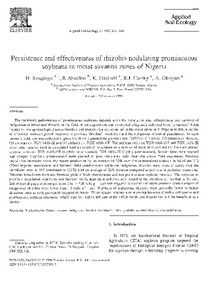| dc.contributor.author | Sanging, N. |
| dc.contributor.author | Abaidoo, R.C. |
| dc.contributor.author | Dashiell, Kenton E. |
| dc.contributor.author | Carsky, R.J. |
| dc.contributor.author | Okogun, A. |
| dc.date.accessioned | 2019-12-04T11:25:04Z |
| dc.date.available | 2019-12-04T11:25:04Z |
| dc.date.issued | 1996 |
| dc.identifier.citation | Sanging, N., Abaidoo, R., Dashiell, K., Carsky, R.J. & Okogun, A. (1996). Persistence and effectiveness of rhizobia nodulating promiscuous soybeans in moist savanna zones of Nigeria. Applied Soil Ecology, 3(3), 215-224. |
| dc.identifier.issn | 0929-1393 |
| dc.identifier.uri | https://hdl.handle.net/20.500.12478/4518 |
| dc.description.abstract | The symbiotic performance of promiscuous soybeans depends upon the population size, effectiveness and survival of indigenous or introduced rhizobia in the field. A pot experiment was conducted using soils collected from 13 farmers' fields located in two agroecological zones (northen and southern Guinea savanna) in the moist savanna of Nigeria to determine the relationships between growth response to previous rhizobial inoculation and the indigenous rhizobial populations. At each farmer's field, soil was collected in plots which were planted the previous year (1993) to: (1) maize, (2) soybean cv. Bossier, (3) soybean cv. TGX 1456-2E and (4) soybean cv. TGX 1660-19F. The soybean cultivars TGX 1660-19F and TGX 1456-2E were either uninoculated or inoculated with an enriched population of a mixture of local rhizobial strains. Four test plants: soybean cultivars TGX 1660-19F (slightly promiscuous), TGX 1456-2E (highly promiscuous), Bossier (non-promiscuous) and cowpea (typically promiscuous) were planted in pots containing soils from the above field treatments. Previous inoculation increased shoot dry matter production by an average of 32% over the uninoculated controls in 94 of the 312 (30%) legume inoculations and farmers' field combinations while the indigenous rhizobia were more effective than the introduced ones in 103 combinations (33%) with an average of 20% increase compared to previous inoculation treatments. Previous inoculation increased biomass yield of both promiscuous and non-promiscuous soybean varieties. The response to previous inoculation treatments was farmers' fields dependent and inversely related to the numbers of rhizobia in the soil. Soil rhizobial population ranged from 0 to > 400 cells g−1 soil and response to inoculation often occurred when numbers of indigenous rhizobia were fewer than 10 cells g−1 soil. Numbers of indigenous rhizobia were generally lower or below detection limit in soils previously cropped to maize. These results indicate a relationship between rhizobia cell counts and promiscuous soybean responses, which may be used to indicate under which conditions inoculation will be beneficial to a farmer. |
| dc.language.iso | en |
| dc.subject | Bradyrhizobia |
| dc.subject | Guinea Savanna |
| dc.subject | Rhizobiaceae |
| dc.subject | Inoculation |
| dc.subject | Root Nodulation |
| dc.title | Persistence and effectiveness of rhizobia nodulating promiscuous soybeans in moist savanna zones of Nigeria |
| dc.type | Journal Article |
| cg.contributor.affiliation | International Institute of Tropical Agriculture |
| cg.contributor.affiliation | University of Hawaii |
| cg.coverage.region | Africa |
| cg.coverage.region | West Africa |
| cg.coverage.country | Nigeria |
| cg.isijournal | ISI Journal |
| cg.authorship.types | CGIAR and advanced research institute |
| cg.iitasubject | Plant Breeding |
| cg.iitasubject | Plant Health |
| cg.iitasubject | Soybean |
| cg.accessibilitystatus | Limited Access |
| local.dspaceid | 100768 |
| cg.identifier.doi | https://doi.org/10.1016/0929-1393(95)00089-5 |

